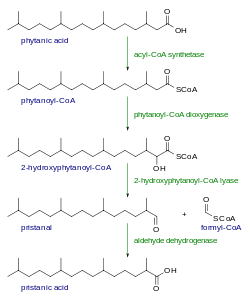Alpha oxidation

Enzymatic steps of alpha oxidation
Pathway
Alpha-oxidation of phytanic acid is believed to take place entirely within peroxisomes.
- Phytanic acid is first attached to CoA to form phytanoyl-CoA.
- Phytanoyl-CoA is oxidized by phytanoyl-CoA dioxygenase, in a process using Fe2+ and O2, to yield 2-hydroxyphytanoyl-CoA.
- 2-hydroxyphytanoyl-CoA is cleaved by 2-hydroxyphytanoyl-CoA lyase in a TPP-dependent reaction to form pristanal and formyl-CoA (in turn later broken down into formate and eventually CO2).
- Pristanal is oxidized by aldehyde dehydrogenase to form pristanic acid (which can then undergo beta-oxidation).
(Propionyl-CoA is released as a result of beta oxidation when the beta carbon is substituted)
Deficiency
Enzymatic deficiency in alpha-oxidation (most frequently in phytanoyl-CoA dioxygenase) leads to Refsum's disease, in which the accumulation of phytanic acid and its derivatives leads to neurological damage. Other disorders of peroxisome biogenesis also prevent alpha-oxidation from occurring.
References
- , Patti A.; Eaton Simon, eds. (1999), Current views of fatty acid oxidation and ketogenesis : from organelles to point mutations, 466 (2nd ed.), New York, NY: Kluwer Acad./Plenum Publ., pp. 292–295, ISBN 0-306-46200-1
This article is issued from Wikipedia - version of the 8/11/2015. The text is available under the Creative Commons Attribution/Share Alike but additional terms may apply for the media files.